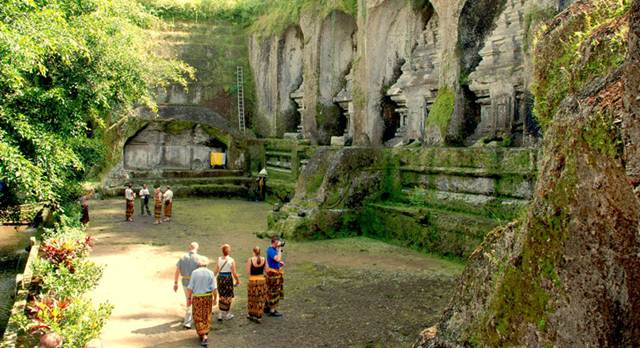Gunung Kawi Temple or Tebing Kawi Temple is a protected ancient site in Bali. Located on the Pakerisan River, Penaka Hamlet, Tampaksiring Village, Tampaksiring District, Gianyar Regency, Bali Province, Indonesia. Source ( Wikipedia)
History :
This temple was built around the 11th century AD during the reign of King Udayana until the reign of Anak Wungsu. King Udayana is one of the famous kings in Bali who came from the Warmadewa dynasty.
Through his marriage to a princess from Java named Gunapriya Dharma Patni, he had children Erlangga and Anak Wungsu. As an adult, Erlangga later became king in East Java, while Anak Wungsu ruled in Bali. It was during this period that the Cliff Kawi temple was thought to have been built. One of the archaeological evidences to support this assumption is the inscription above the pseudo-door which uses Kediri letters which reads "haji lumah ing jalu" which means the king (symbolically) is buried in Jalu. The king in question is King Udayana.
While the word jalu which is a designation for spurs (weapon) on a rooster, can also be associated with a keris or pakerisan. The name Pakerisan River or Pakerisan Tukad is what is now known as the name of the river that divides the two cliffs of the Kawi Temple. This temple was rediscovered by Dutch researchers around 1920.
Gunung Kawi Temple Has about 315 steps on the banks of the Pakerisan River. The beautiful atmosphere that can be seen from the grove of trees on the banks of the river, as well as the gurgling water from this sacred river in Bali makes visitors feel as if they are being greeted by a symphony of nature. The steps to get to Gunung Kawi Temple are made of solid stone framed by stone walls.
Arriving at the temple complex, tourists will witness two groups of enshrinements separated by the Pakerisan River. The first temple is located on the west side of the river, facing east, of which there are four. While the second temple is located on the east side of the river, facing west, there are five of them. The temple complex on the west side also features a bathing pool and shower. Witnessing these two temple complexes, tourists will be amazed by the sight of rock walls that are neatly carved to form curved spaces in which there is a temple. These temples are deliberately made in the basin to protect it from the threat of erosion
Arriving at the temple complex, tourists will witness two groups of enshrinements separated by the Pakerisan River. The first temple is located on the west side of the river, facing east, of which there are four. While the second temple is located on the east side of the river, facing west, there are five of them. The temple complex on the west side also features a bathing pool and shower. Witnessing these two temple complexes, tourists will be amazed by the sight of rock walls that are neatly carved to form curved spaces in which there is a temple. These temples are deliberately made in the basin to protect it from the threat of erosion


